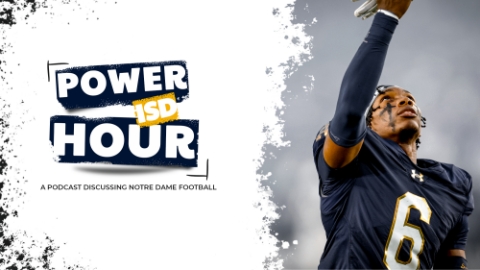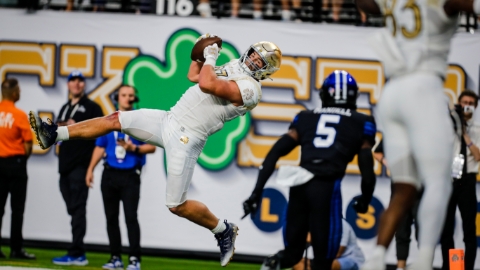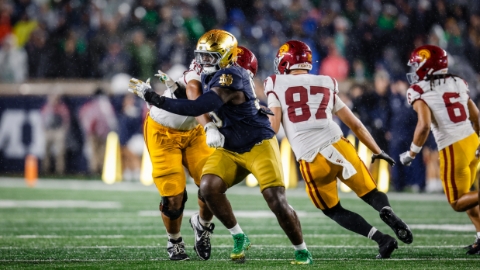
After breaking down the back and forth that took Notre Dame and Clemson to a draw at the end of regulation in the first of two match-ups, I now want to dive into the plan of attack for Tommy Rees and the Irish during the two overtime periods.
Clemson took the ball first on the +25 and brought motion across the QB’s face for a double play action with him and the RB, before hitting a glance route for what appeared to be a 1 play strike. After a review, the officials ruled it down at the 1 yard line, which set up a QB plunge from DJ Uiagalelei on a power play.
The Irish offense then trotted out on the field in the first overtime, trailing 40-33, and lined up in the same exact formation Clemson did on their first offensive play in overtime, only flipped because it was on the right hash, as opposed to the left.
In overtime, the offensive team gets to choose where they want the ball placed. You can put the ball on the right or left hash, in the middle, or also request the “right-middle” or “left-middle,” which is essentially lined up on the upright or 10 feet 8 inches from the hash mark, to be exact.
The Irish took the ball on the right hash and set two WR’s into the boundary, bringing the slot WR in motion faking the jet sweep and handing inside zone (with TE stay on backside) to Kyren Williams.
Clemson lined up in an Odd defense in the first defensive snap of overtime. Being in a 3-down front was not new for the Tigers in this game, however playing in a 3-safety look with the middle safety at intermediate depth (deeper than the LB’s, more shallow than the other 2 high safeties) was a first for the Clemson defense in this game.
Interestingly, the middle safety used as the “free runner” is freshman Tyler Venables (circled in Gold below), the son of Clemson defensive coordinator Brent Venables. While this is a new look for the Tigers in the game, it is not actually the safeties that make the play here.
Rees smartly opts for the ball on the hash mark and sets the formation into the boundary. The reason he did this was typically the formational weak-side overhang defender playing to the field would split the difference between the end man on the LOS and the nearest receiver. For some reason, Vennables guesses correctly here and keeps LB Trenton Simpson, circled in Green below, on the LOS and was not influenced by the open field to cover on his side.

As you can see in the Gif above, the LB outside the box in the boundary falls back into the box with motion, giving even numbers, 6 blockers for 6 defenders. The problem is you can see that the OL & H-back do not take that into the count pre-snap. Therefore, Michael Mayer works inside, rather than turnout on Simpson. If the count would’ve accounted for 6 defenders pre-snap, ND would have them all accounted for and have a “hat-for-a-hat.” Regardless, the Irish find themselves at 2nd & 8.
Rees sets up in essentially the same formation, only flipped and includes Mayer on the LOS, instead of off the ball. The Irish go straight drop-back pass that is known as a traditional “Y-Cross” concept, where in this case, Avery Davis works across the field to the opposite hash, with the aiming point usually being at 22 yards across the field.
Venables goes with the same defensive look with his son Tyler in the middle, only this time he bluffs both inside LB’s, with one covering the RB in man coverage and the other spying the QB. Tyler Venables comes down closer to the LOS in order to cover the TE man-to-man. The Tigers are in “2-Man” coverage, which is man-to-man across the board underneath and 2 high safeties over the top. This is what is referred to, often incorrectly by commentators, as “bump-and-run” coverage during NFL games.
Here you can see Book make a great throw on the move to find Mayer on the sideline during the scramble. It is tough to criticize Book after making a superb throw with his shoulders not square to the LOS, however he could have made life easier if he went to his first read on this concept, which is to Davis. If the safety comes off the hash mark to play the Mayer corner route as he does here, the ball should go to Davis on the deep crossing route. Typically versus “2-Man,” he would have someone playing him man-to-man underneath, however Clemson blows the coverage here and Book just misses it - as you can see here.
With a 3-man rush, Book could have easily stepped up and delivered a strike to an open Davis, but instead he got happy-feet and flushed out of the pocker a little prematurely. Again, easy for me to say and in spite of this, he still made a fantastic play.
Here you can see Book’s perspective. His key on this play is the safety to his right. If he flies off the hash to cover the corner route, he should step up and deliver a strike.
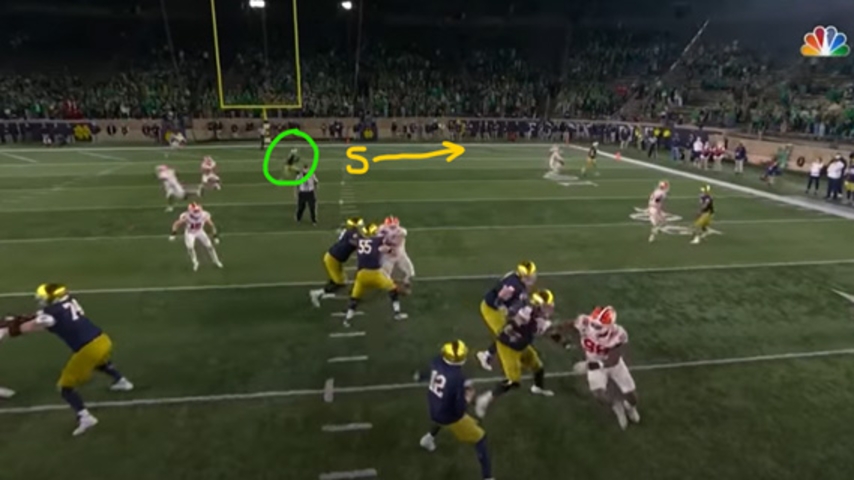
After missing the read, Book does a great job of keeping his eyes down field and finding a receiver. However, I think it is important to note that all good offenses have set scramble drill “rules” and practice them often. Meaning, while it may look haphazard and chaotic, there are built-in details that often go unnoticed. While there are different variants among offense, a common approach is out breaking routes convert to going “up,” corner routes come back “down,” on the sideline. Square-in routes break to the corner, post routes come back downhill to the sideline, and so on.
Those examples are for when the QB scrambles to their side, but generally if the QB scrambles away, most receivers will work downhill towards the QB. This is so defenders cannot step into throwing lanes to easy interceptions.
For the QB, he is usually taught that once he hits the hash mark, he can throw from the hash to the sideline, he gets to the numbers, it’s from the numbers to the sideline, and so on. Basically, just a way of defining “never throw across your body” during scramble, Patrick Mahomes notwithstanding.
Clearly, based on this play, Rees and company did a great job teaching and practicing these concepts, or a version very close to it. The result was a big pickup for the Irish to find themselves 1st & Goal, from the 8-yard line.
Here, Rees gives a different look, but it is the same type of concept on the TE side as the previous play only with a slight twist. After motioning Tommy Tremble over to Mayer’s side, the Irish send Tremble into the flat just as the RB did prior and Mayer looked like he was running the exact same route (a corner route) as the last play, only to “nod” it and keep bang a skinny post.
Tough to tell from this angle, but it does look like Book might’ve missed this read as well for the touchdown opportunity versus a match-man defensive concept. Instead, he takes it down to the drag and ND is 2nd & Goal from the 3-yard line.
Next up, Rees decides to go back to 13 personnel in what started out as a “spread set.” He shifted down to a tight unbalanced set, which put the Clemson defense on their heels.
As you can see here, the Clemson defense shifts down and “kicks the defensive front” the wrong way, leaving a very soft front versus a 6-man ND surface. The result is the Irish collapse their left side and the Irish tie it back up, sending the game into double overtime!
Rees comes out in 11 personnel to start the 2nd OT as the Irish get the ball first this time. Clemson presents the same look as they did to begin the 1st OT, which was the Iowa State Look with a free-runner middle hybrid safety who is actually part of the defensive run-fit. The problem is Clemson has 7 guys in the run-fit and Notre Dame has 6 blockers. Usually, in today’s football, teams will account for this extra defender with an RPO option in the run game.
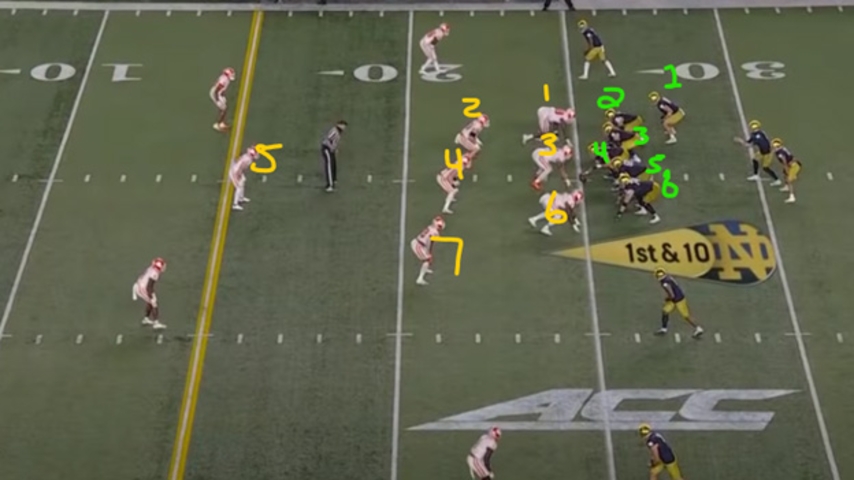
While Notre Dame certainly has plenty of RPO options in their toolbelt, for some reason they opt out of using one of them and it costs them. Again, it is tough to me to be overly critical in a 47-point thriller of a win, but understanding how Tyler Vennables fits into this defense should have been discussed and ironed out in-between overtimes, given this was debuted on the first play of the first OT.
While Tyler Venables is not the one who makes the play here, you can see right guard Tommy Kraemer turn back versus the plugging Inside LB based on their count pre-snap for outside zone, therefore the Clemson NG gets over the top and makes a play for a loss of a yard.
On 2nd & 11, Ian Book takes a QB draw down to the one yard line, but off-setting penalties negate the big gain and netted 1st & 10 at the 20 yard line. Rees chooses to go 12 personnel on this play, but again Clemson has too many in the box and an unblocked defender hits Williams for a 5 yard loss. This brings up 2nd & 15, where the Rees decides to go to a drop-back pass. The Tigers have good coverage and a spy dedicated to Book, but somehow he still takes off and scrambles for a pickup of 12, which brings up 3rd & 3.
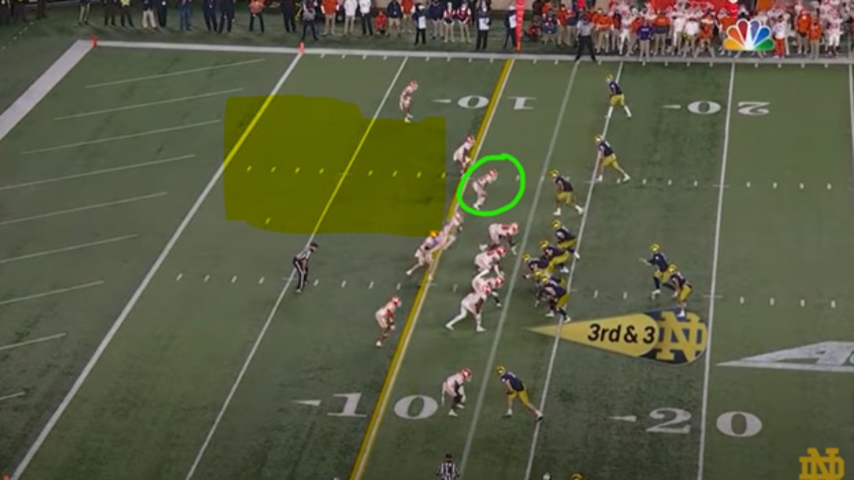
Above is the 3X1 spread formation Rees lines up in next and the defender circled blitzes, but it is the QB’s responsibility to see that he is not “capped off,” meaning there is no safety over the top of the defender. Clemson has a major bust here, but Book is locked into Ben Skowronek on the boundary throw and still wins out on the tougher choice. Good pitch and catch here, but an easy TD was missed as you can see below.
1st and Goal, ND is stuffed with a run up the middle versus a GL defense. Alas, the Irish are 2nd & G at the 3 yard line and Rees goes with an unbalanced formation to the right and gets the Tigers to line up incorrectly. Clemson is out leveraged to the offensive right and this allows two great double teams up front, great angles, and an isolation for Tremble to take on the playside supporting safety. Take a look:
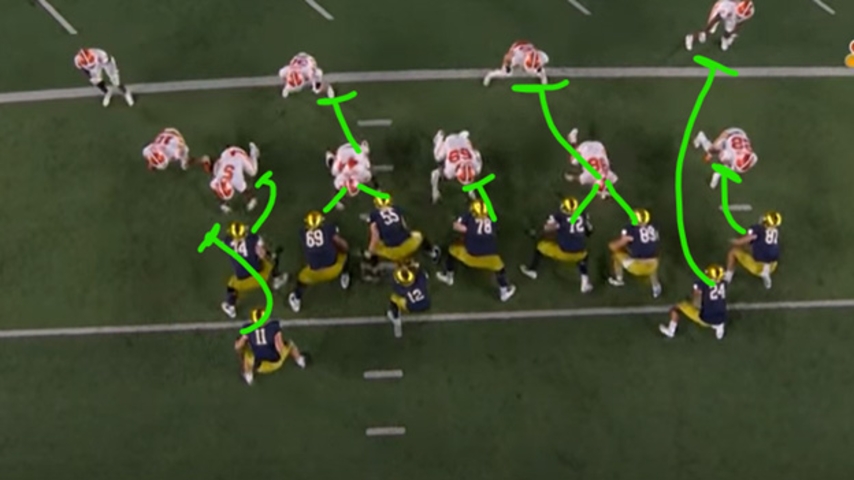
Strong run here by Williams gives the Irish the lead and Clemson gets their final shot on offense.For the Tigers, they get a bit too cute, going with a funky quads play action that results in a loss on first, a fake QB toss Power Read play action (yes, all of that in one play) on 2nd down, that results in a loss, and an incompletion on 3rd and 24. Finally, the green QB is left with 4th and 24 and the Irish come out with a big-time win.
As you can see from the overtime breakdown, Rees/Book made it more difficult on themselves a few times than needed to be, however they stuck with running with football downhill on key downs and it paid off for the Irish.
I am looking forward to breaking down ND/Clemson #2 for 2020 and also doing some positional breakdowns as well. It was a fascinating year for Rees and company, but with a lot of new offensive parts, it will be fun to dive into how some of those positions could play out!
